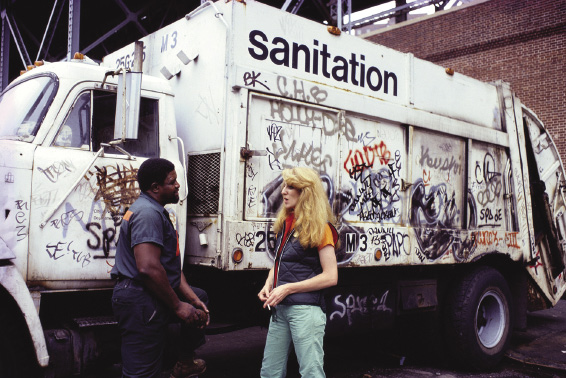
Mierle Laderman Ukeles ’61 has spent the last four decades as the unsalaried artist-in-residence of the New York Department of Sanitation, where she brought so-called menial labor out of the shadows. For one of her projects, Touch Sanitation , she spent 11 months shaking the hands of all 8,500 workers at the sanitation department’s facilities and in the streets, saying to each person, “Thank you for keeping New York City alive.”
The Queens Museum has mounted the first solo survey exhibition of her work, “Mierle Laderman Ukeles: Maintenance Art,” which is open through February 19. Holland Cotter, in a review in The New York Times , calls Ukeles (pronounced YOU-kah-lees) “a social revolutionary who understands the power of service.” The Times named the exhibit to its “Best Art of 2016” list.
Ukeles’ interest in maintenance work developed after she became a mother in 1968 and, in her view, became a “maintenance worker.” Taking care of a child, she saw, involved doing the same tasks every day to keep the baby alive, healthy, and robust as well as clean and fed, and left little time for her work as an avant garde artist. The same kind of commitment to maintenance work was required, she came to realize, to keep anything functioning—a building, a university, a city— and those who performed it were largely ignored.
She began this new kind of artwork herself. Her maintenance work, she said, was her art. “I am an artist. I am a woman. I am a wife. I am a mother. (random order). I do a hell of a lot of washing, cleaning, cooking, renewing, supporting, preserving, etc. Also, (up to now separately) I ‘do’ art.” She became New York’s sanitation department’s artist-in-residence in 1977, an unprecedented position that has since become a model for Los Angeles, St. Paul, Boston, and Chicago in embedding artists in municipal departments. Ukeles has also worked on projects with service workers in France, Holland, and Japan.
“Art belongs to everyone and belongs everywhere,” says Ukeles, who now lives in Jerusalem and works internationally. In her work, she says, she is posing the questions, “Who are the people who are doing this necessary work (in maintenance)? Is their necessary work honored? Is our dependency upon them and their labor manifest by our culture? If not, why not?”
There was no studio art major when Ukeles attended Barnard, so she focused on international relations and history. The critical inquiry and deep research she engaged in, especially for her thesis on Tanzania’s quest for independence, helped inspire the direction of her artistic work, she says. She found parallels between “the struggles of pursuing national freedom for new countries and the struggle in the pursuit of personal freedom as an artist.”
Ukeles’ next project addresses our society’s power to transform its former sites of waste disposal. Landing will be the first permanent work of art to be built at the former landfill now called Freshkills Park in Staten Island, which is gradually becoming one of the largest environmental parks in the region.
— Images courtesy of Ronald Feldman Gallery, NYC
